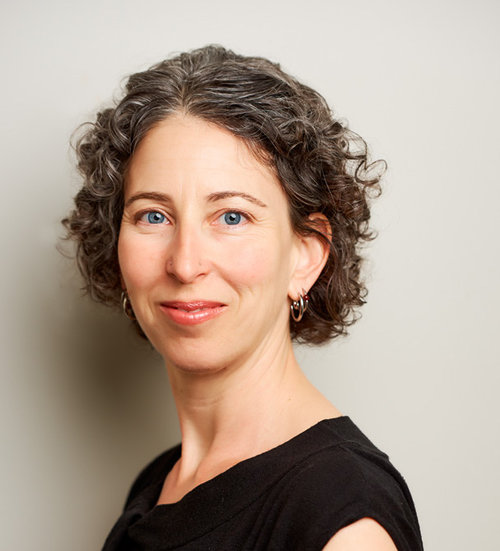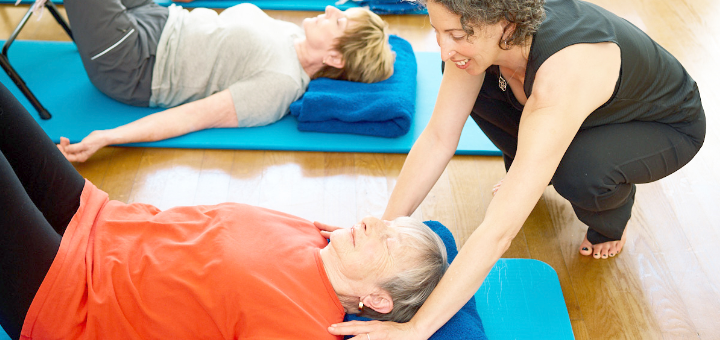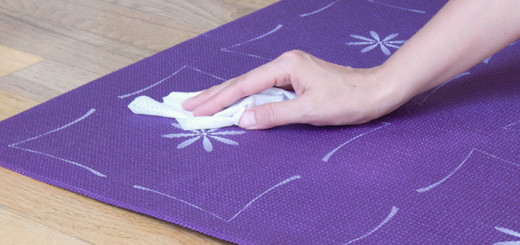The Pros and Cons of Teaching Yoga in an Integrative Medicine Center
6
by Rachel Lanzerotti, yoga teacher and yoga therapist
I’ve had the chance to work on great projects as a yoga teacher involved with research— to study whether and how yoga can help with heart health, chronic back pain, and cancer care. Teaching therapeutic yoga classes and working with yoga research studies were two parts of my pathway. Perhaps my experience can be helpful to those of you who are curious about teaching in medical research and integrative health centers.
I used to joke that I wedged a toe into the integrative medicine door, and then after a couple years stuck my foot in there. After five or six years, an entire leg made it into the room…. By now, a decade after I began, I can see how the efforts of many researchers, yogis, and patients have opened the door to a much wider stream of yoga research and therapeutic yoga classes. Growing evidence for yoga’s benefits helps, too. Today there may be more opportunity to work in integrative clinical and research settings, as yoga teachers and therapists, particularly in service of nonpharmacological alternatives to conventional treatment.
This is how I started teaching yoga in a prestigious medical research and education center. As a relatively new yoga teacher in 2007, I studied restorative yoga with senior teacher Judith H. Lasater and subsequently assisted several years’ cycles of her restorative yoga teacher trainings. To build one’s own teaching skills and confidence in personal practice, there is nothing equal to assisting an excellent teacher over time.
It happened that Judith was advising a research project, Practicing Restorative Yoga and Stretching for the Metabolic Syndrome (PRYSMS, which I’ve written about elsewhere). I was fortunate to be among those she recommended to teach with Dr. Alka Kanaya’s study. At that time, I was transitioning into full-time yoga teaching after many years of consulting in research and evaluation for community organizations, with a strong background and interest in research methods and health education.
Here are a few things the restorative yoga teachers did with PRYSMS:
- Adhered to a teaching protocol (limited set of postures, sequences);
- Filed research notes;
- Maintained close communication with study participants;
- Attended regular team consultations; and
- Taught restorative yoga (two evenings per week for two years) for groups of people at high risk for the metabolic syndrome.
After PRYSMS, Dr. Kanaya recommended me to substitute-teach a public class for cancer survivors at the institution next door. Long story short, I became the primary teacher for that class over time. As the only yoga teacher in that setting for several years, I made it a priority to attend organizational events and to meet key administrators and staff. Meanwhile, I continued and diversified my professional development and training, and I was there when another, new research study needed a teacher of mindful breathing for prehypertensive menopausal women.
I share these details to make a few main points about my experience here— it required training, time, patience. My success depended upon showing up, committing to ongoing professional development, cultivating relationships, and, often, advocating for yoga and for myself as a teacher. At that time, yoga was a marginal offering in many respects— in my view it unfortunately still is, because of how funding works. This also meant that I became an “ambassador” and educator about yoga for medical staff and providers.

The opportunity to design and teach public, therapeutic yoga classes didn’t come for another six years. It grew out of teaching with yet another research project on yoga for chronic back pain (YoMA). Calls for research participants with chronic back pain garnered so much interest that I made the case for public classes in a 5-7 week series that repeated.
I’m proud to say the therapeutic yoga series for low back pain started “selling out” consistently: waiting lists, very positive evaluation forms (remember to create an intake process and substantive evaluation forms for your classes!), and student requests for more. In response, I proposed other therapeutic topics (e.g., to address upper back/neck pain, digestive health) and started to build a yoga program. I’m grateful to clinicians, researchers, and administrators who supported these efforts, referred their patients, and even participated themselves!
For yoga teachers and therapists who want to serve in an integrative health and/or research setting, I suggest you seek out informational interviews with health providers and researchers working with the populations/communities and topics that interest you. Contact other yogis who already teach for these groups or settings and ask if you can assist or observe them. My hunch is you’ll find ways to offer yoga where there’s a clear need.
The end of the story for me isn’t what I wished, as my initial ambition was to build a continuous, robust yoga program in this setting. The program worked for a few years, but funding was a primary consideration and obstacle. I finally let go of efforts to keep the door open, worn down by institutional limitations and logistics and how those negatively impacted marketing, registration, and the bottom line. I’m sorry to say the classes have not continued.
From course evaluations and personal notes they sent me in the years that followed, I’ve heard the benefits to these students of learning therapeutic yoga in an integrative medicine setting. I’m glad that the classes were there for them.
For me, this experience corresponded with training to become an IAYT-Certified Yoga Therapist. In seeing many diverse students with complex heath issues, my teaching skills improved, and private practice grew through reputation.
I view the chance to teach and learn from students with complex health conditions as a bonus of being in a medical setting. Most yoga teachers will want to seek out additional training, supervision, and mentorship in working with diverse populations, and some settings and topics will be more suited to yoga therapist-level training and certification.
A quick balance sheet of pros and cons…
Here is a quick balance sheet (disclaimer: from this yogi’s experience only) of cons and pros of teaching yoga in medical centers. Perhaps, allow the “cons” to serve as possible caveats and the “pros” as potential encouragements.
Cons/Caveats:
- Medical centers operate within the context of a confusing, and many would say broken, health care system;
- The “bottom line” of funding, insurance and grants will limit programming, creativity and compensation;
- Yoga teachers and therapists often are at the bottom of a professional hierarchy, unless also licensed practitioners;
- You may need to go an extra (and very worthwhile) step to introduce yourself to colleagues;
- You may need to educate colleagues and the institution about yoga and yoga therapy, as you may be the sole provider/teacher in that setting.
Pros:
- Working with diverse students with complex health conditions and people who may not attend public studio classes (in my experience more men, older adults, people of color, people for whom English is a second language);
- Opportunities to collaborate and consult with health providers and professional network;
- Learning to work with research protocols and/or designing curriculum and creating intake and evaluation processes for your classes;
- Teaching with research studies as well as for specific populations;
- Professional development/learning opportunities, conferences, seminars.
Teaching and developing yoga research in a medical center offered me unique opportunities to learn, contribute, and grow professionally that I haven’t found elsewhere; it also required persistence. This is an area to seek mentorship and talk with yoga teachers and yoga therapists who have experience in your particular setting.
(© 2019 Rachel Lanzerotti, Five Rivers Yoga LLC.)
[jetpack_subscription_form]
About Rachel
Rachel Lanzerotti (MSW, eRYT500, IAYT-Certified Yoga Therapist) is the Founder of Five Rivers Yoga Therapy and creator of The RE/ST Method for Pain Recovery™. She is a Body-Mind Yoga Therapist, meditation teacher, counselor, health educator and specialist in back pain relief.

Rachel has taught at UCSF Osher Center for Integrative Medicine and Spirit Rock Meditation Center, and was a featured presenter on “The Modern Science of Yoga” at the SF Asian Art Museum. She also launched the Aging Well program of San Francisco Village. She is a faculty member of Essential Yoga Therapy, where she mentors and teaches yoga teachers and therapists-in-training.
Rachel has been published in numerous journals, research studies, and periodicals including Stanford Magazine, and with the Boston Women’s Health Book Collective on topics ranging from yoga, health, aging, and sexuality to gender, racial justice, and human rights.
She holds a BA in Human Biology from Stanford University and Master of Social Work (MSW) from San Francisco State University. For a decade prior to founding Five Rivers Yoga Therapy, Rachel ran an organizational consulting practice with community-based groups. She spent many years focused on direct action work for nonprofit and social change organizations.




















The timing of this is hopeful. As a health educator and yoga instructor feeling at a loss as i sit in the waiting room of a spine specialist.
Namaste
Michelle, all best wishes to you!
Thank you for sharing your experiences!
Amy, thank you for reading!
Thanks for sharing.
Thanks for reading, Charlene!